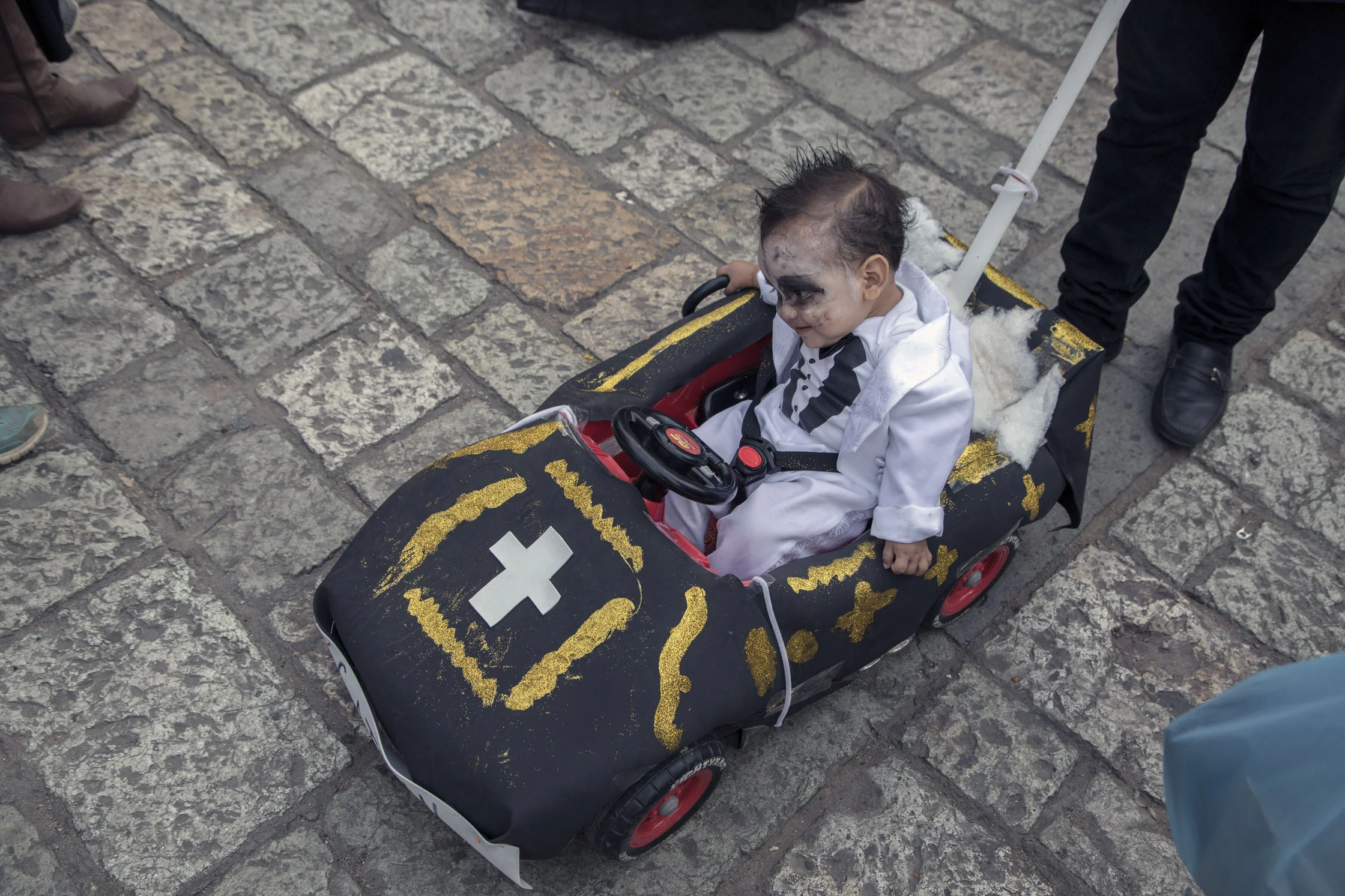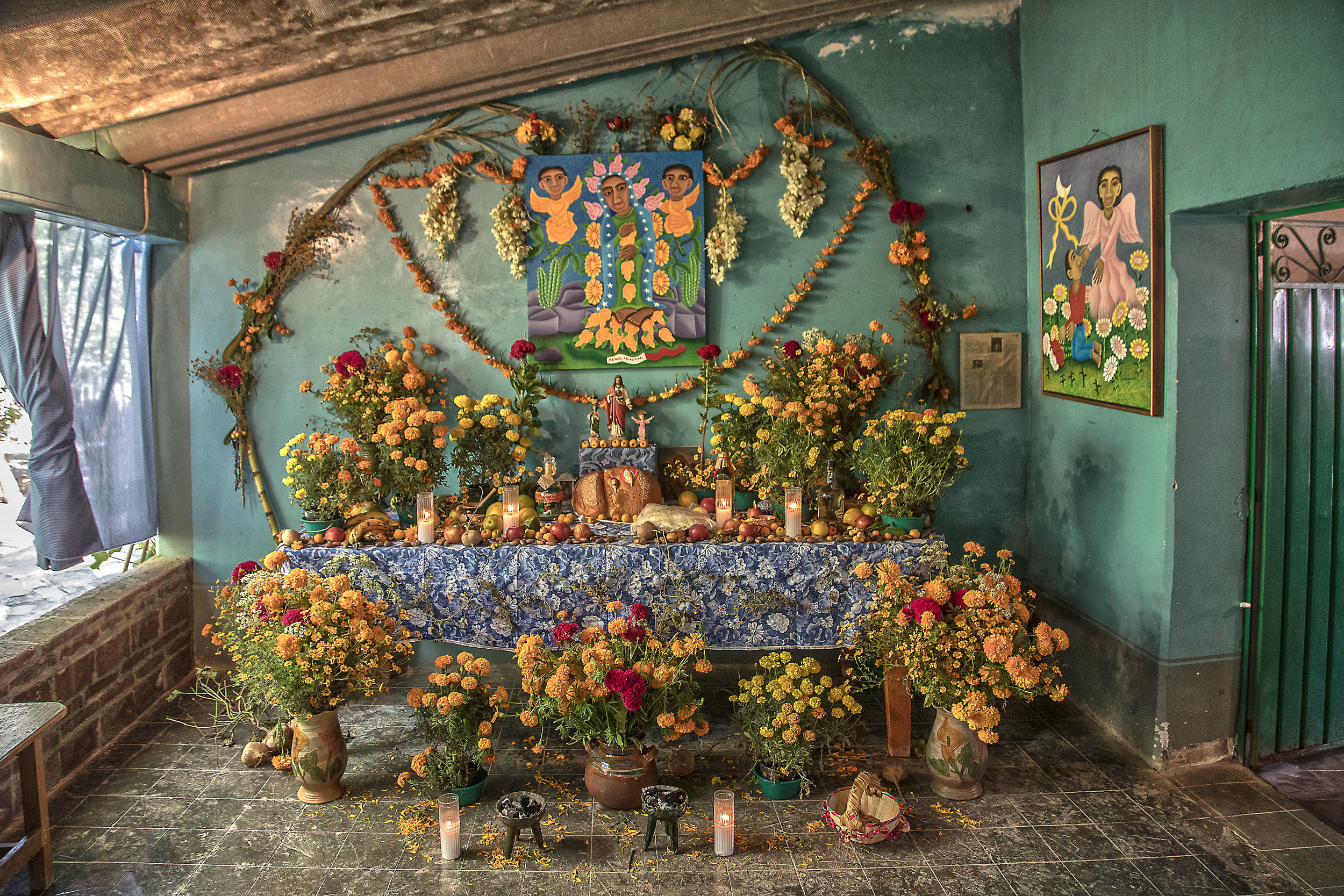Using cheap Halloween masks, a blood-red trident and a scythe, local children pose for pictures and money donations.
Costumed children in a comparsa for Día de Muertos (15)
Schools and civic organizations parade through the streets of Oaxaca in the days prior to the Dia de los Muertos. Parades of costumed groups are called Comparsas
The children of Día de Muertos in Oaxaca (14)
School children procession competing for best costume for Día de Muertos (13)
Oaxaca, Mexico
Costumes from the United States intended for Halloween make their way to Dia de Muertos ceremonies.
Cockscomb flowers used for Día de Muertos (12)
Cockscomb & Marigolds (11)
Cockscomb flowers (Celosia argentea var. cristata) and Marigolds (Tagetes erecta) are common mortuary flowers used in Oaxaca for Día de Muertos.
Fleurs de los Muertos (10)
Cempasúchil, aka marigolds, are the traditional flower of the dead and are the most-used flowers during this holiday. The Aztecs gathered the wild plant as well as cultivating it for medicinal, ceremonial and decorative purposes. In Zapotec society, it was chosen for two reasons: yellow is the color of death and for it’s strong fragrance.
Día de Muertos (9)
A mother and her two sons walk the streets of Oaxaca. Their costumes attract tourists and provide an opportunity to collect money for their school.
Chinas Oaxaqueñas - detail
Although there are no immediately obvious Chinese references in the costumes the dancers sew themselves, or in the jewelry they wear, the Chinas Oaxaqueñas retain their enigmatic name, which comes from the “Barrio de China,” a neighborhood that was home to a large population of Chinese factory workers and builders in the mid-20th century. Known in Spanish as Chinas, they taught the native Oaxacans in their neighborhoods how to do silk embroidery, and their legacy remains in the silk rebozos—the shawl-like scarves that add brilliant, but demure, coverage, for a dual purpose that is both reverent and festive. Source: https://www.vogue.com/article/china-oaxaquena-oaxaca-city-mexico-folk-dancer-costumes-video-guelaguetza-calendas
Calenda de Bodas in Oaxaca
Chinas Oaxaqueñas accompany the bride and flower girl in a wedding parade through the streets of Oaxaca
Children of Dia los Muertos (8)
In recent years Halloween costumes and masks featuring Marvel superheroes and Disney princesses have overshadowed the celebration of Dia los Muertos in Mexico. A recent resurgence of local folk characters are seen in this image of a costume and make-up contest near the Zocalo in Oaxaca City.
The present form of the celebration of the Day of the Dead in Mexico has come about through a lengthy and circuitous historical development, which has resulted in the fusion of certain southern European folk practices, medieval and Renaissance Catholic rituals, and indigenous Mesoamerican customs. The feast of of All Saints’ Day and the liturgical celebration of All Souls’ Day have long existed in the European Christian world.*
*Days of Death, Days of Life by Kristin Norget, Columbia University Press, 2006
Costume contest for Día de Muertos (7)
Sitting between his parents a boy watches the local contest for costume and make-up as a Calavera in Oaxaca.
Tapetes de Arena (6)
Historically, the creation of sand tapestries was a Oaxacan mortuary custom. They are found all over Oaxaca City as a decoration on the street and in hotel displays during Día de Muertos.
Oaxacan sand painting in a busy marketplace
Tapete of the Virgin of Solitude and a statue with the skull head of a Catrina decorate the entrance to the Hotel Marques Del Valle.
Exhibition of Traditional Tapete de Levantada de Cruz at the Panteon de Santa Cruz Xoxocotlan
Description in English of the Traditional Sand Art in Xoxocotlan
The cross-raised rug is a symbol of the Catholic Church, their elements represent the Calvary Mount, recalling the place where Jesus Christ died. Inside the carpet selects the passion of Jesus, as you can see:
At their sides we can find the stairs, symbolizing that they were occupied when the Holy Men Nicodemus and Joseph of Arimathea lowered the body of Jesus.
To the right you can see the hammer with which they nailed Jesus to the cross, the nails that pierced the hands and feet of Jesus, the crown of thorns which they placed on Jesus’ head to call him King of the Jews, the cock that crowed then Jesus’ apostle Peter had denied him three times.
To the left is the second hammer, the sign describing that Jesus was the King of the Jews, the spear with which the soldier Longing opened the side piercing his heart and spilling the last drops of blood.
More below we find two angels bowing to the cross, meaning the shelter that Jesus had in the tomb, the candle represent the faith that the deceased had to the religion, two vases with their respective flowers signify the refuge with which the body was embalmed of Jesus; the chalice that symbolizes the Sacrament of the Eucharist which is the food of salvation.
Tapete de Levantada de le Cruz are portals between life and death. They are created by craftsman called rezadors. The tradition pre-dates the arrival of the Spanish conquistadors to Mexico, but the subject matter of sand paintings and their imagery was transformed using Catholic iconography.
Hand-painted map of the international borders of Mexico
Clearly delineated from the gray lands of El Norte, hand-painted on a coarse wooden board is Mexico as a brightly colored mermaids tail. The Day of the Dead is celebrated throughout Mexico, especially in the central and southern regions.
Carved wooden comic folk art figures in Oaxaca
Detail of altar with pan de muertos (5)
“Pan de muerto (Spanish for bread of the dead), also called pan de los muertos or dead bread in the United States, is a type of sweet roll traditionally baked in Mexico during the weeks leading up to the Día de Muertos, which is celebrated on November 1 and 2. (Wikipedia)”
Día de Muertos, The Ofrenda (4)
An ofrenda (Spanish: "offering") is a collection of objects placed on a ritual altar during the annual and traditionally Mexican Día de Muertos celebration. An ofrenda, which may be quite large and elaborate, is usually created for an individual person who has died and is intended to welcome him/her to the altar setting.
A common format for an ofrenda contains three levels or tiers. The topmost tier identifies the dead person who is being invited to the altar, frequently with photos of the deceased, along with images of various saints, statuettes of the Virgin Mary, crucifixes, etc. which are positioned in a retablo which forms the back of the altar on the second tier are things placed to encourage the dead to feel at home and welcome: the deceased person's favorite food items might go here, including such things as mole, candy, pan dulce, and especially a sweet bread called pan de muerto. For deceased adults, the ofrenda might include a bottle or poured shot glasses of tequila or mezcal, while if the deceased is a child a favorite toy might be placed here. The bottom-most tier almost always contains lit candles, and might also have a washbasin, mirror, soap, and a towel so that the spirit of the deceased can see and refresh themselves upon arrival at the altar. (Wikipedia)
Traditional hair braids joined using ribbon in Oaxaca
Many Zapotec women wear their hair in two long braids using ribbon to keep it out of the way of daily tasks like cooking, cleaning and weaving.
A face in the crowd (3)
Celebrated as weeklong fiesta Día de Muertos is both a solemn remembrance of recent deaths and a happy reunion with visiting ancestors; a time to gossip with departed relatives about the daily follies of politicians and neighbors since their last visit from the village of the dead.
Día de Muertos in Oaxaca (2)
Contemporary Catrina in Oaxaca
































